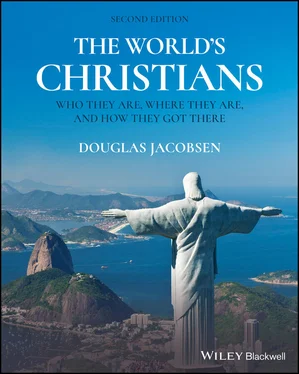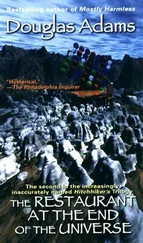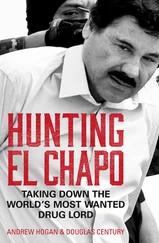Despite its wide dispersion across the globe, many people still think of Christianity as a “western” religion. During the four centuries from 1400 to 1800, most Christians in the world were, in fact, European; about 85 percent of all the Christians in the world lived in that single region. Christianity had flourished in parts of Asia and Africa in earlier centuries, but it contracted to Europe during these four centuries when coincidentally Europe was also beginning to spread its influence around the world. These centuries of European domination had a profound and lasting impact on global perceptions of Christianity. People worldwide came to see Christianity and Europeanness as two sides of the same coin. Christianity was reconceived as a purely “western” religion, and actions undertaken by anyone in “the West” were often attributed to Christianity.
The idea that Christianity is a western or European religion is sometimes reinforced by western Christians who are themselves often convinced that their own way of being Christian is the only or best way of being Christian and that all other ways are deficient or mistaken. While some Christians may continue to presume that western Christianity is the norm for all Christians everywhere, that is no longer the demographic reality. Christianity was a global faith for much of its history, and it is a thoroughly global movement today.
World Christianity as a Field of Study
The phrase “world Christianity” is used by scholars of Christianity to indicate that their research and writing is not narrowly focused on western forms of Christianity but instead encompasses Christianity in all its global diversity. Studying world Christianity means learning about and comparing all the diverse expressions of Christian faith that now exist around the world. This comparative work usually fits into one of four categories: missiological, ecumenical, postcolonial, or religious studies.
Scholarship undertaken from a missiological perspective aims to help Christian missionaries (who communicate Christian ideas and ideals across cultures to people who are not Christian) do their work more effectively. Individuals engaged in the missiological study of world Christianity seek to answer this question: Where is Christianity succeeding or failing (growing as a movement or shrinking), and what are the causes of that success or failure? Like all scholars, people who study world Christianity missiologically want to know facts about the movement and not just advance their own opinions. However, they are typically interested in using that knowledge to strengthen Christianity globally. Not surprisingly, most individuals who adopt a missiological perspective are Christians themselves.
The ecumenical perspective, like the missiological, seeks to enhance Christianity worldwide, but its goal is to encourage and facilitate the unity of Christians globally, quite apart from whether or not the movement is growing. The purpose of the ecumenical movement has historically been to unite churches as institutions, rather than Christians as individuals, so this style of world Christian studies usually stresses the beliefs, practices, and organizational structures of the world’s many different churches. The central question for scholars studying world Christianity ecumenically is: What can all the different Christian churches learn from each other, and how can that knowledge help Christians relate more positively with each other?
A third category of world Christian studies can be termed “postcolonial.” The focus of postcolonial study is on the dynamics of life in regions of the world that were once colonized by one or another European nation, which includes about half the world. In many of these previously colonized places, Christianity was introduced (or reintroduced) to the region as part of the colonizing process. As colonialism has slowly come to an end, many Christian churches in these formerly colonized countries have rejected at least some of the western understandings of Christianity that were imposed on them and have developed their own local, indigenous views of what Christianity can or should be. Scholars with a postcolonial perspective focus their work on these new non‐western, indigenous developments and often see them as inherently more valid and authentic than the colonial forms of Christianity that preceded them. A key question posed by scholars with a postcolonial perspective is: What does (or what might) Christianity look like once it is freed from western domination?
The fourth category is that of “religious studies,” which is the approach taken by researchers who seek to be dispassionate and descriptive. Their goal is not to help Christians advance their faith around the world (like missiology) or to encourage Christian unity (an ecumenical perspective) or to champion a less western understanding of Christianity (the postcolonial approach). Instead, the goal of the religious studies approach is to understand and to describe how and why Christianity has taken root in various parts of the world and what those different varieties of Christianity look like. While no scholar can be completely objective or perfectly fair, the intention of religious studies is to avoid making normative judgments about which kinds of Christianity are better than others. From the perspective of religious studies, differences within the Christian movement are seen as mere differences, not as matters that require moral or spiritual assessment. While personal beliefs, values, and ideals will inevitably seep into any human endeavor, scholars who take a religious studies approach seek to bracket their own biases as much as possible. Their key research question is the simple query: How is Christianity practiced similarly and differently around the world and why? The World’s Christians uses this religious studies approach.
How This Book Is Organized
The goal of this book is signaled in the volume’s subtitle: to explain who the world’s Christians are, where they currently reside, and how they got there. The “who” section describes the main theological and organizational divisions that exist among the world’s Christians, the “where” section identifies the particular experiences of Christians living in various regions of the world, and the section on “how they got there” provides a brief history of Christianity’s global growth and development.
“Who are the world’s Christians?” is answered in Part Iby describing the four largest Christian sub‐traditions, which are called “mega‐traditions” in this book: Eastern Orthodoxy, Roman Catholicism, Protestantism, and Pentecostalism. Taken together these four groups account for roughly 97 or 98 percent of all Christians worldwide. The chapters in this section of the book describe the spirituality (the lived character and general religious ethos) of each of these traditions, how each group understands the Christian idea of salvation , the institutional structure of each group, and the story of each group’s origins and subsequent development.
Part IIof The World’s Christians describes how Christianity came to assume its current global shape. It includes four chapters, each covering 500 years of Christian history. These chapters explain both the internal (spiritual and theological) developments of the Christian movement and Christianity’s external engagement with the world’s different cultures. This section of the book underscores the dynamic character of Christianity, how it grew from being a tiny religious movement in the Middle East into the incredibly complex faith it is today. While Christianity has been a world religion for a very long time, its global shape has changed dramatically over the course of the last two thousand years, and it is still changing today.
Читать дальше












